千島列島の火山 Volcanoes of Kuril
- 千島列島の火山 北千島の火山写真
- 国際千島調査2000報告 (International Kuril Island Project 2000)
- サリチェフ火山の概説
中千島の火山写真
南千島の火山写真
『国際千島調査2000報告』
- Volcanic Activity and Recent Tephras in the Kuril Islands: Field Result during the International Kuril Island Project(IKIP) 2000 -
1. Introduction
Tephras derived from large explosive eruptions have been widely known to be good key marker layers not only to construct volcanic histories but also to estimate the age of remains in archaeological deposits. While many key marker tephra layers related to the large explosive eruptions have been well investigated in Japan and Kamchatka (e. g. Machida and Arai 1992; Braitseva et al. 1997), few tephras have been identified in the Kuril Islands that connect these larger land masses.
The International Kuril Island Project (IKIP), composed of American, Russian, and Japanese scientists, has studied the biodiversity of the Kuril Islands since 1994. During the IKIP 2000 of this past summer, archaeological and geological researchers joined the IKIP project. A preliminary tephrochronological investigation was conducted around mid to late Holocene archaeological sites on the coast of eleven islands of the Kuril Islands (Fig. 1). These islands are Shumshu, Paramushir, Onekotan, Kharimkotan, Shiashkotan, Raikoke, Matua, Ushishir, Simushir, Chirpoi, and Urup. The author reports here the IKIP 2000 field results relating to recent Kuril tephras in order to evaluate volcanic activity and estimate the age of remains in the archaeological excavations.
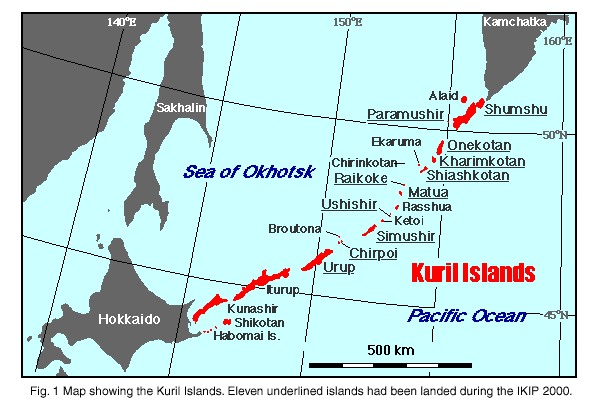
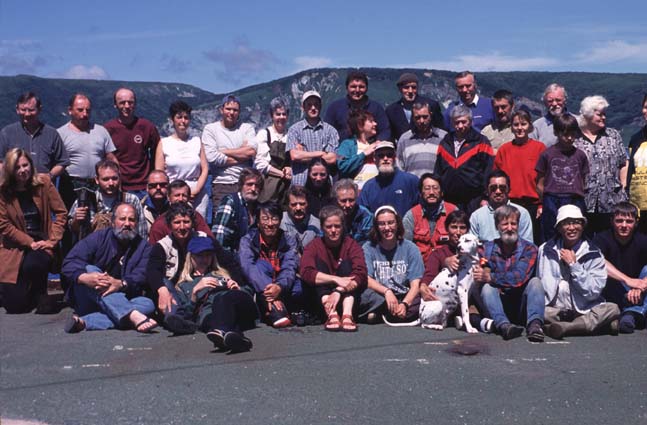
Members of the IKIP 2000 off Urup Island.
2. General Geology and Volcanic Activity of the Kuril Islands
The Kuril Islands include an older inactive arc (Lesser Kuril Ridge) and a younger volcanic active arc (Greater Kuril Ridge), the later extending for 1200 km from Cape Lopatka on Kamchatka to the Nemuro Peninsula on Hokkaido in the NW Pacific (Nemoto and Sasa, 1960; Gorshkov, 1970). The Lesser Kuril Ridge is located between the Greater Kuril Ridge and the Kuril-Kamchatka trench. It is composed of volcanics and sediments from Upper Cretaceous to Paleogene. In contrast, the Greater Kuril Ridge formed from vigorous submarine volcanic activity beginning in the Miocene and is composed of many Quaternary volcanoes that consist mainly of composite volcanoes with lesser calderas.
The Greater Kuril Ridge is divided into three regions, northern, central, and southern on the basis of the submarine topography and the thickness of the crust. The Kruzenshtern Strait of 1,900 m below sea level separates the Northern Kuril Islands (Shumshu to Shiashkotan) from the Central Kuril Islands (Matua to Simushir). The deepest strait (Boussole Strait) of 2,200 m below sea level divides the Central Kuril Islands from the Southern Kuril Islands (Chirpoi to Kunashir). The Northern and Southern Kuril Islands have the greater thickness of the continental crust (15~30 km), whereas the thinnest oceanic crust (10~15 km) comparable to that of the oceans is in the Central Kuril Islands (Gorshkov, 1970; Tuyezov, 1971). In the Greater Kuril Ridge 160 Quaternary terrestrial volcanoes and 89 submarine volcanoes are recognized (Gorshkov, 1970). Thirty-two of these volcanoes have been active in historical time, since the early 18 century. Nineteen of the active volcanoes have erupted since 1945 (Gorshkov, 1954; Simkin and Siebert, 1994).
Explosive eruptions of Volcanic Explosivity Index (VEI) over 4 (eruptive volume over 0.01 km3), that are defined on the basis of their eruptive volumes (Simkin and Siebert, 1994), have been recorded on 30 Kuril volcanoes during the Holocene (Table 1). Since the 18 century, 10 large explosive eruptions of VEI over 4 have been recorded on composite volcanoes (Fig.2). These inlcude the 1790 and 1981 eruptions of Alaid volcano, the 1853 and 1986 eruptions of Chikurachki volcano on Paramushir Island, the 1872 eruption on Shaishkotan Island, the 1778 and 1924 eruptions on Raikoke Island, the 1946 eruption on Matua Island, the 1712 eruption on Chirpoi Island, and the 1973 eruption of Tyatya volcano in Kunashir Island. Very large explosive eruptions (VEI of 6) with a total volume of ejecta of 10 to 100 km3 formed three calderas: Tao-Rusyr Caldera on Onekotan Island, Ushishir Caldera on Ushishir Island, and Lvinaya-Past Caldera on Itrup Island, which have been dated to 14C ages of 9,400 y.B.P., 9,400 y.B.P., and 7,500 y.B.P, respectively (Gorshkov, 1970; Braitseva et al., 1995; Fig.2). These explosive eruptions could have generated tephra deposits across wide regions of the Kuril Islands.

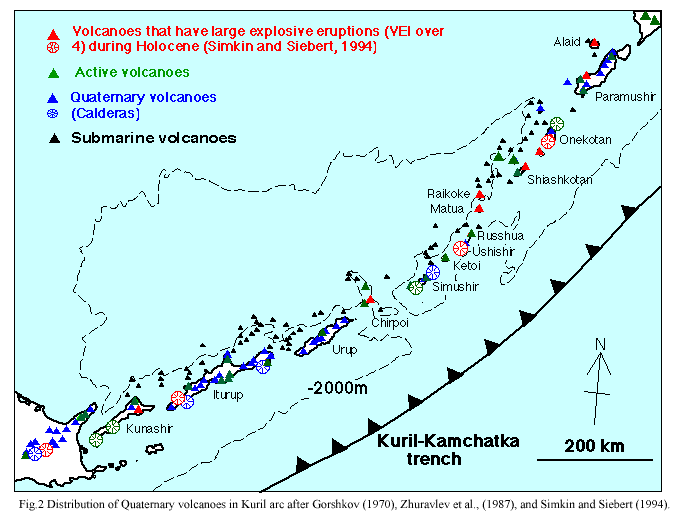
Tephrochronological studies focus on soil-tephra sequences, representing a history of explosive volcanic eruptions. Tephras consist of all pyroclastic materials ejected from a volcano. Stratigraphically they can be separated by soil, eolian sandy loams or peats. One sheet of tephra refers to the pyroclastic materials of a series of one eruption without large-scale interruptions. During IKIP 2000, soil-pyroclastic sequences were investigated at locations close to boat landings determined by the research needs of biologists and archaeologists. Cross sections roughly 2 m deep and 1 m wide were made at the coastal or near coastal cliffs. The sites of the cross sections were chosen at the relatively heights and plains to include terraces and bluffs at different elevations. Features of stratigraphic relationship, color, thickness, sorting, and maximum diameters of essential ejecta of each individual tephra were described at each sections. The tephras were divided into two genetic types, pyroclastic flow deposits and pyroclastic fall deposits according to their sorting. The pyroclastic fall deposits were further subdivided into three types -- ash, pumice, and scoria fall deposits -- in terms of their grain size and color.

R/V OCEAN of Russian Academy of Science.
Despite an absence of Quaternary volcanoes on Shumshu, 11 layers of tephras were found in a 130 cm deep (from the surface) cross section of a 12 m above sea level (a.s.l.) sea cliff of on the western coast (Fig. 3). The tephras consist of brown to yellowish ash fall deposits and black to reddish scoria fall deposits.
The most remarkable tephra in this sequence can be recognized as a yellowish layer of ash fall deposits 83 to 102 cm below surface. Under the stereoscope, it has the grain diameters of < 1.0 mm and the minerals of plagioclase and hornblende with a small amount of pyroxenes. Most of glasses in this tephra are classified into bubble wall types that are frequently found in the tephra derived from large explosive eruptions that typically form calderas (Machida and Arai, 1992). Judging from color, isopach maps, and mineral assemblages (Braitseva et al., 1997), the remarkable tephra could be equivalent to the KO tephra derived from Kuril Lake Ilinsky caldera, southern Kamchatka erupted in 7666 y.B.P.
Five other ash fall deposits can be recognized as layers varying in thickness from 2 to 5 cm. Considering the main direction of the ash fall deposits, the tephras may be partly originated from explosive eruptions from southern Kamchatka volcanoes such as Khodutkinsky Maar, which erupted in 2805 y.B.P., or Ksudach volcano, which erupted in 1090 y.B.P. (Melekestsev et al.,1996; Braitseva et al., 1997).

On Matua Island, in the central Kurils, at least 19 tephra layers were found in a 150 cm deep cross section from 15 m a.s.l on the surface of a Tertiary basement hill at the southern end of the island (Fig. 4). These layers consist of diverse fall deposits of pumices, scoriae, and ashes as well as pyroclastic flow deposits. Most of the layers were probably derived from the composite cone, Sarychev Peak, in the center of the island because the cone had been intermittently erupted in the historical time (Simkin and Siebert, 1994). The uppermost thick tephra layer (14 cm thick) that consists of black scoria fall deposits from 14 to 28 cm in depth from the surface may be derived from explosive eruptions such as the historical eruptions in 1930, 1946, or 1960 (Table 1).
The cultural layer of an archaeological site has been also found from 96 to 110 cm depth from the surface at this section. The layer is visible as dark brown loams with the shards of earthenware and many carbonized woods up to a diameter of 4 cm. This layer is interbedded between light gray ash fall deposits and brownish yellow pyroclastic flow deposits.
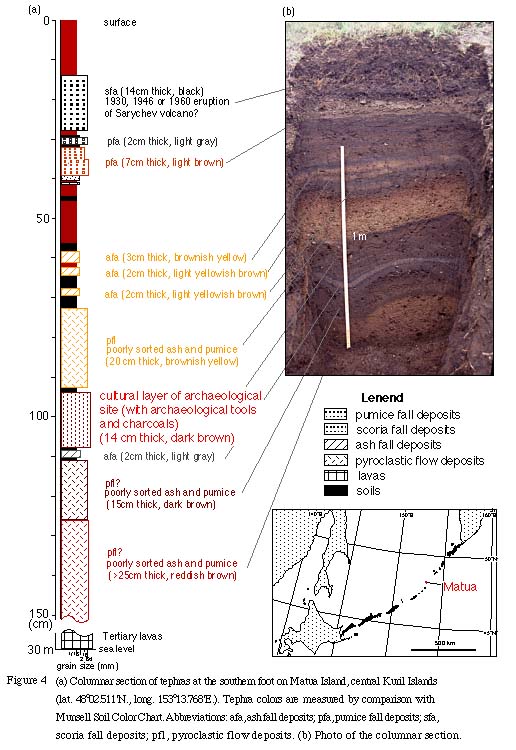
Eight tephra layers have been found along a 300 cm deep cross section 18 m a.s.l. on the northern coast of in the Chirpoi Island, in the southern Kurils (Fig. 5). The tephra layers consist of ash and pumice fall deposits. In this section, thick, poorly continuous epiclastic sands are also accumulated, probably as dune deposits.
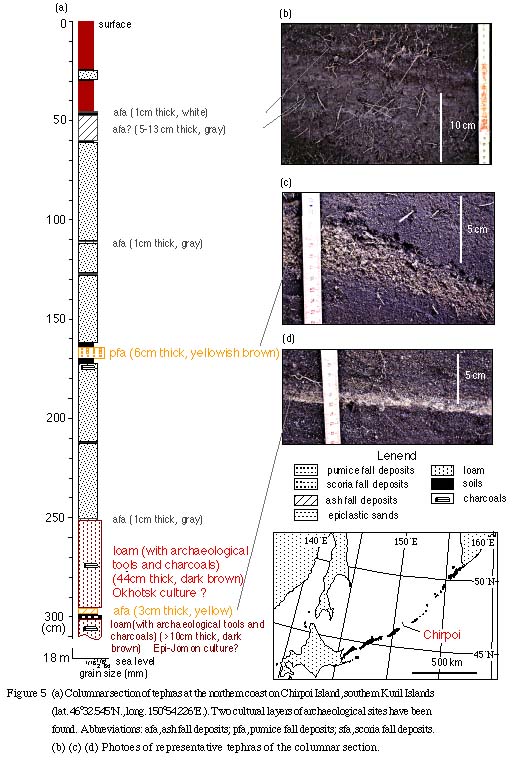
Two remarkable tephra layers can be recognized: yellowish brown pumice fall deposits and yellow ash fall deposits. The upper pumice layer that has 6 cm thick and the grain diameters of <5 cm could be derived from the volcanoes of the Chirpoi Island, probably andesitic to dacitic Chernyi volcano in the center of the island. The lower yellow ash layer of 3 cm thick is interbedded with cultural layers of archaeological sites that are visual as dark brown loams. Both cultural layers have the shards of earthenware and many charcoals.
The uppermost tephra layers at this section consist of white and gray ash fall deposits from 45 to 60 cm deep from the surface. These layers may be derived from historical explosive eruptions of Chernyi volcano, those that are the 1712 eruption of VEI of 4, and 1857 eruption of VEI of 3 (Table 1).
7. Preliminary ConclusionsDuring IKIP 2000, at least 70 tephra layers have been found on the eleven Kuril Islands of Shumshu, Paramushir, Onekotan, Kharimkotan, Shiashkotan, Raikoke, Matua, Ushishir, Simushir, Chirpoi, and Urup Islands. These tephras consist mainly of ash fall deposits with lesser pumice and scoria fall deposits and pyroclastic flow deposits. On Shumshu Island, three tephra layers of ash fall deposits may be compared with the tephras derived from volcanoes of the southern Kamchatka erupted before ca. 1,000 to 8,000 years. On Matua and Chirpoi Islands, notable tephra layers together with cultural layers of archaeological sites have been found. The age of these layers will be estimated using by the 14C dating of the charcoals and relative age of the earthenware. Remarkable tephras found on each islands will be also identified on the basis of their grain sizes, colors, mineral assemblages, glass types as well as the chemical compositions of glass shards.

Calm with kelp off Ekarma Island.
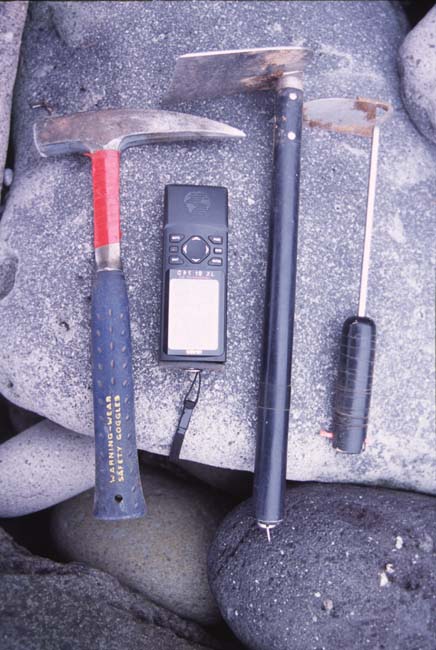
My research tools; Hammer, GPS, Hand hoe, and Hand sickle.

Go back to the ship off Matua Island.

Sunset off Iturup Island.
I am indebted to Ben Fitzhugh and Theodore Pietsch of the University of Washington for the invitation to participate in the IKIP 2000. I thank the captain and crews of R/V OCEAN of Russian Academy of Science for supporting this research. I would like to thank Kaoru Tezuka, Carole Mandryk, Christopher Lockwood, Scotty Moore, Cristie Boone, and Valery Shubin and his colleagues of the archaeological team of the IKIP 2000 for gracious assistance. I thank Mitsuhiro Nakagawa of Hokkaido University for helpful discussions.This material is based upon work supported by the National Science Foundation under Grants No. 9505031 (Pietsch, P.I.) and 9910410 (Fitzhugh, P.I.).
REFERENCESBraitseva, O. A., I. V. Melekestsev, V. V. Ponomareva, and L. D. Sulerzhisky, (1995) Ages of calderas, large explosive craters and active volcanoes in the Kuril-Kamchatka region, Russia. Bulletin of Volcanology 57:383-402.
Braitseva, O. A., V. V. Ponomareva, L. D. Sulerzhisky, and I. V. Melekestsev (1997) Holocene key-marker tephra layers in Kamchatka, Russia. Quaternary Research 47:125-138.
Gorshkov, G. S. (1954) Chronology of eruptions of volcanoes in the Kurile chain. Trudy Lab. Vulkanol. 8:58-99 (in Russian).
Gorshkov, G. S. (1970) Volcanism and the Upper Mantle. Plenum Press, 385p.
Machida, H. and F. Arai (1992) Atlas of Tephra in and Around Japan. Univ. Tokyo Press, 276p. (in Japanese)
Melekestsev, I. V., O. A. Braitseva, L. I. Bazanova, V. V. Ponomareva, and L. D. Sulerzhitskiy (1996) A particular type of catastrophic explosive eruptions with reference to the Holocene subcaldera eruptions at Khanger, Khodutka Maar, and Baraniy Amfiteatr volcanoes in Kamchatka. Volcanology and Seismology 18:135-160.
Melekestsev, I. V., O. N. Volynets, and Yu. Antonov (1997) Nemo III Caldera (Onekotan I., the Northern Kuriles): Structure, 14C age, dynamics of the caldera-forming eruption, evolution of juvenile products. Volcanology and Seismology 19: 41-64.
Nemoto, T. and Y. Sasa (1960) Geological map sheets of the Kurile islands (1/250,000 scale).
Simkin, T. and L. Siebert (1994) Volcanoes of the world. Geoscience Press, 345p.
Tuyezov, I. K. (1971) Crustal structure of the Okhotsk and Japanese areas from regional seismic prospecting data. Proceedings of the First Japan-USSR Symposium on Solid Earth Sciences, edited by S. Asano and G. B. Udintsev, pp. 121-135, Tokai Univ. Press.
Zhuravlev, D. Z., A. A. Tsvetkov, A. Z. Zhuravlev, N. G. Gladkov, and I. V. Chernyshev (1987) 143Nd/144Nd and 87Sr/86Sr ratios in recent magmatic rocks of the Kurile Island arc. Chemical Geology 66:227-243.